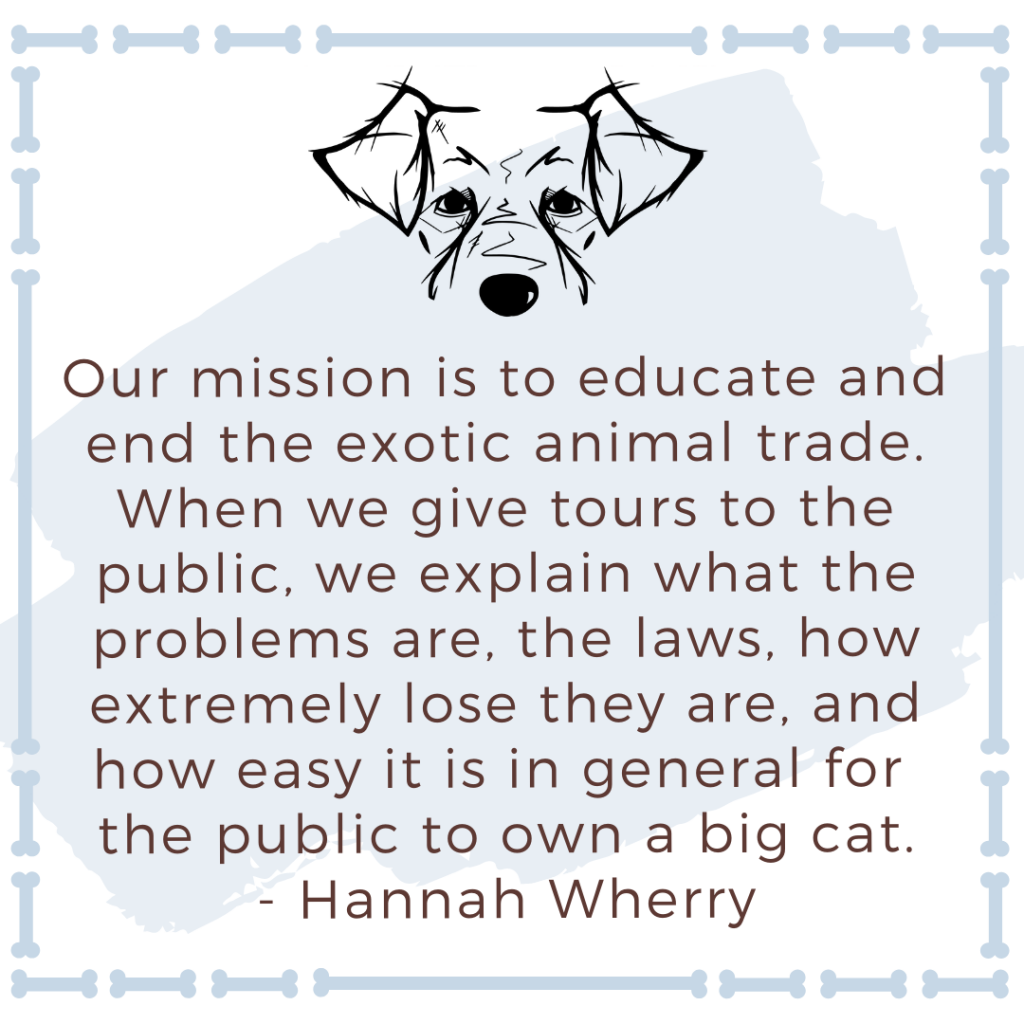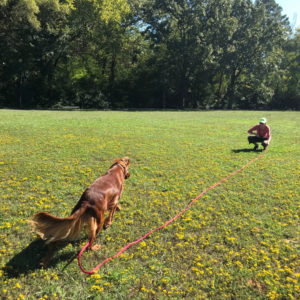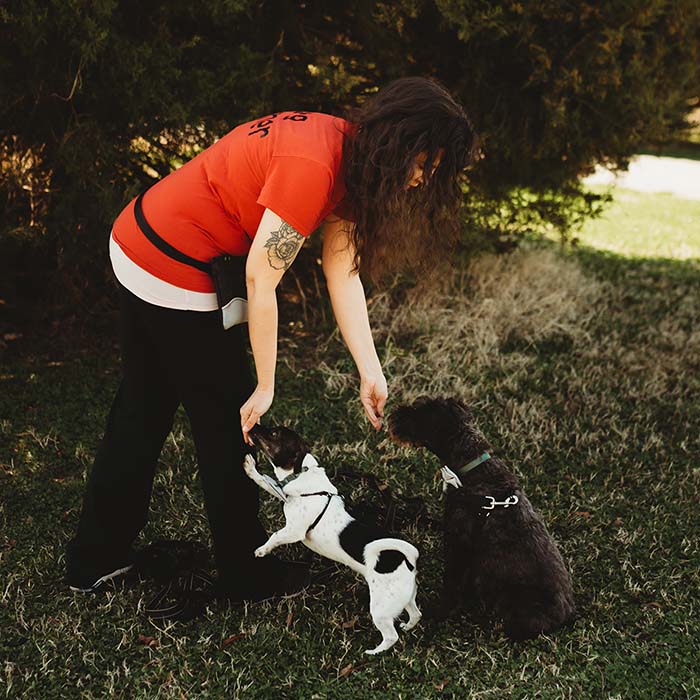A True Sanctuary: Rescue in Arkansas
A repurposed three-part series
They’re soft, cuddly–and endangered.
Roadside zoos and other attractions that boast the ability to pet a tiger or lion cub are pretty popular across the United States. An exotic cub can cost as little as $750 or up into the thousands, which can be a misleading number about the life-time cost of wild cats.
It was eons ago that I interviewed Hannah Wherry, a wildlife interpreter in the Education Department at Turpentine Creek Wildlife Refuge. This was supposed to be part of a larger article for a pet magazine, then I decided to run the series as a three-part, and then life got insane. But here it is, now that Tiger King isn’t relevant anymore.
At the time of our interview, fourteen of the rescues at the refuge were bred by Joe Exotic, the infamous character pitted against Carole Baskin in the Tiger King Netflix series. His given name is Joseph Maldonado-Passage, and since we talked, Joe’s company in Oklahoma, Greater Wynnewood Development Group, LLC, was granted to Carole by court ruling. It includes 16 acres of land. Read more about the ruling.
Since 2019, Joe has been serving a 22-year sentence for a hit attempt on Carole and other crimes. Read more.
Out of the fourteen rescues bred by Joe, all but five were born at his facility while they filmed Tiger King. The animals were sold to others who ended up not being able to care for them. Some of the cubs were sold at a week old, while others were sold a bit older when they could no longer legally be used for cub petting.
While a cub might cost a few thousand dollars, the long-term costs can quickly add up. Hannah explained that food alone can cost $10,000 a year. That doesn’t include veterinary care, enrichment toys, and activities to keep the cats active and mentally stimulated, or supplements and medications. In 2019, the overhead cost for the refuge, which is home to 88 big cats total, was close to three million dollars.
Most of the cats who call the refuge home are victims of the exotic pet trade and entertainment industry. “We are constantly working to increase public awareness about the plight of big cats in captivity,” Hannah explained.
For Hannah, her obsession with big cats started when she was a child. “I’ve seen pictures of myself even before I can remember carrying around tigers and stuffed animals,” Hannah shared. “I always thought I’d be more on the keeper side.”
She grew up in Colorado, earning her Bachelor’s of Science in Fish, Wildlife, and Conservation Biology from Colorado State University. Learn more about Hannah . “I came out here blindly,” Hannah said. “I’d never been to Arkansas before coming out to Turpentine.”

She first participated in the animal care program and realized then that she didn’t want to be a keeper. All interns at Turpentine Creek are required to have a bachelor’s degree, regardless of the department. Every six months, fifteen new interns work in animal care at the refuge, coming from all over the country. “We get good people and it’s wonderful experience in the exotic animal field,” Hannah said. “Animal care is very competitive whether working at a zoo or a sanctuary. It takes six months to get a foot in the door in order to get paid internships.”
After her internship, Hannah found what she really wanted to do. “I found that I love giving tours and I love talking to people,” Hannah said. “I bothered staff. I told her I wanted to start an education internship, so that’s how the education department started about three years ago at the refuge.”
Hannah works closely with Beckie Moore, the education coordinator. Beckie was the one to introduce Hannah to interpretation. “She worked at Arkansas parks for a very long time,” Hannah explained. “With her interpretation skills and my science skills, we started this education department together.”
A wildlife interpreter is someone who teaches about animals, Hannah explained. She and her coworkers became Certified Interpretive Guides through the National Association of Interpretation in order to teach people why they should care and what they should do. “The purpose of an interpreter is to make whatever you’re teaching about, like big cats, matter to the public,” Hannah said. “Why should other people care about sanctuaries and tigers?”
A big part of that education process is breaking down misconceptions regarding big cats, which includes understanding that big cats can be held in captivity and still be endangered. “I think there’s a perspective that because they’re in captivity that they’re not wild animals,” Hannah shared. “There’s a disconnect between, ‘Oh, there’s a tiger in front of me, they’re in captivity, they’re not wild and they’re not endangered.’ There are way too many tigers in captivity that are privately owned outside of credited zoos and sanctuaries.”
Since the education department began three years ago, they’ve added an internship and four salaried employees. Typically, overall at the refuge, there are 15 animal care interns and 50 employees. With COVID-19, Turpentine Creek closed to the public and only kept one maintenance staff member and others crucial for the care of the animals. It was easy for animal care staff to quarantine with lodging directly on site.
Office staff and others who lived off-site worked from home.
The education department stayed busy with 45-minute virtual programs for K-6 schools, focusing on predator education. This included explaining why big cats weren’t pets and what they could do to help. Hannah was almost completely booked the week that we spoke. “It’s been great to have that sort of outreach and be able to talk to so many schools,” Hannah shared. “That’s not only here in Arkansas but throughout the country and overseas.”
With an impact in over sixty classrooms, the education department tracked how many miles they traveled virtually. Within the first half of the year, they traveled over 80,000 miles using Zoom. “It’s a great platform to still see the students and interact back and forth,” Hannah said. “We share videos and pictures of the species. It’s been a lot of fun.”

Due to the high costs of running the refuge, visitors are a crucial part of the refuge. Thousands of people visit every year, and by Hannah’s count, it was about 65,000 visitors in 2019. With having to close, the refuge lost 65% of donations. Turpentine Creek relies on donations and support from the general public to survive. They were able to feed the animals frozen meat for the moment, and usually get donations from companies like Tyson.
While Turpentine Creek was closed when Hannah and I first spoke, it is now open for limited visitors. Masks are required and it is highly encouraged to purchase tickets ahead of time. Click here to learn more.
And of course, they’ve gotten more attention after the popularity of Tiger King. Hannah shared that it helped create a national platform to show the issues happening with big cats. “I think it also focused too much on the characters in the show,” she explained. “It was definitely not a documentary. It was a drama series to create views.”
Plus, there was a lack of true education in the series. “How it hurt us is that it didn’t differentiate between a roadside zoo and a true sanctuary that rescues animals from these people and provides a forever home,” Hannah shared.
In addition, there was no distinction between a for-profit and nonprofit entity. But fortunately, since Turpentine Creek has been in Eureka Springs for 23 years, there’s been a lot of time to build relationships with people who understand and support the refuge.

In general, it’s been 50-50 with how Tiger King has impacted the refuge. “People are aware that this is going on in our country,” Hannah said. “Then it created a mass of memes and misinformation in general. We’ve always known about not just Joe Exotic, but these characters have exploited or abused and neglected animals. My perspective was, ‘Thankfully, there will finally a Blackfish of the big cat world that will expose all of the negativity going on,’ and it did not do that, so that was disappointing in my opinion.”
The pandemic has influenced Turpentine Creek more than the television series, Hannah shared. But their mission continues. “Our mission is to educate and end the exotic animal trade,” Hannah said. “When we give tours to the public, we explain what the problems are, the laws, how extremely lose they are, and how easy it is in general for the public to own a big cat. … Our mission is just to rescue big cats that need it and end the exotic trade. We don’t want to see these animals abused for cub petting or entertainment anymore.”
Find more about Hannah’s work at Turpentine Creek at their website. This piece was originally intended to be a part of a larger article as content for an upcoming pet magazine. Telltail Dog Training offers group classes and private in-home lessons in the Little Rock area, along with training walks for current clients. Find Telltail’s podcast here, or find additional information on Instagram, Facebook and YouTube.




